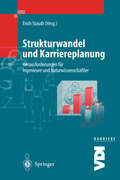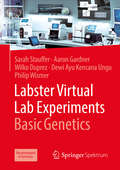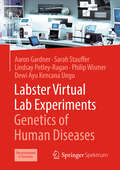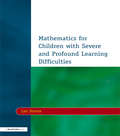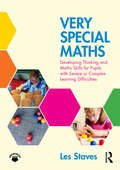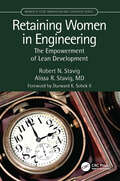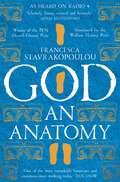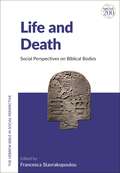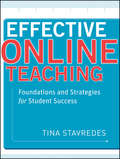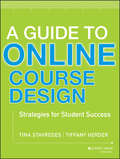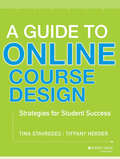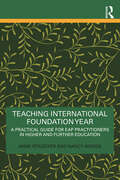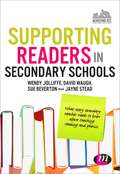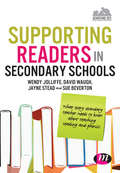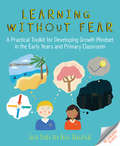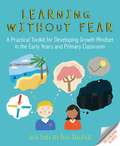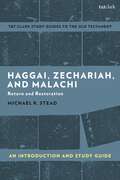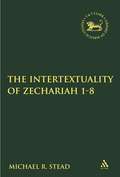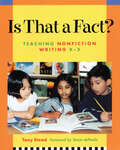- Table View
- List View
Strukturwandel und Karriereplanung: Herausforderungen für Ingenieure und Naturwissenschaftler (VDI-Buch)
by Erich StaudtDie Situation der Ingenieure und Naturwissenschaftler am Arbeitsmarkt hat sich in den letzten Jahren dramatisch verändert. Der klassische Karriereweg von der Hochschule in die Industrie besteht nur noch in Ausnahmefällen. Ein grundsätzliches Umdenken ist deshalb unumgänglich. Das Buch zeigt die neuen Herausforderungen für diese Berufsgruppen und daraus resultierende Konsequenzen für die Berufs- und Karriereplanung. Es wendet sich an Aus- und Weiterbildungseinrichtungen ebenso wie an die betroffenen Berufsgruppen selbst.
Labster Virtual Lab Experiments: Basic Genetics
by Sarah Stauffer Aaron Gardner Wilko Duprez Dewi Ayu Ungu Philip WismerThis textbook helps you to prepare for both your next exams and practical courses by combining theory with virtual lab simulations. With the “Labster Virtual Lab Experiments” book series you have the unique opportunity to apply your newly acquired knowledge in an interactive learning game that simulates common laboratory experiments. Try out different techniques and work with machines that you otherwise wouldn’t have access to.In this volume on “Basic Genetics” you will learn how to work in a laboratory with genetic background and the fundamental theoretical concepts of the following topics:Mendelian InheritancePolymerase Chain ReactionAnimal GeneticsGene ExpressionGene RegulationIn each chapter, you will be introduced to the basic knowledge as well as one virtual lab simulation with a true-to-life challenge. Following a theory section, you will be able to play the corresponding simulation. Each simulation includes quiz questions to reinforce your understanding of the covered topics. 3D animations will show you molecular processes not otherwise visible to the human eye. If you have purchased a printed copy of this book, you get free access to five simulations for the duration of six months. If you’re using the e-book version, you can sign up and buy access to the simulations at www.labster.com/springer.If you like this book, try out other topics in this series, including “Basic Biology”, “Basic Biochemistry”, and “Genetics of Human Diseases”.
Labster Virtual Lab Experiments: Genetics of Human Diseases
by Sarah Stauffer Aaron Gardner Dewi Ayu Ungu Philip Wismer Lindsay Petley-RaganThis textbook helps you to prepare for your next exams and practical courses by combining theory with virtual lab simulations. The “Labster Virtual Lab Experiments” series gives you a unique opportunity to apply your newly acquired knowledge in a learning game that simulates exciting laboratory experiments. Try out different techniques and work with machines that you otherwise wouldn’t have access to.In this book, you’ll learn the fundamental concepts of the genetics of human diseases focusing on:Monogenic Disorders - Cytogenetics - Medical Genetics - Viral Gene TherapyIn each chapter, you’ll be introduced to one virtual lab simulation and a true-to-life challenge. Following a theory section, you’ll be able to play the relevant simulation that includes quiz questions to reinforce your understanding of the covered topics. 3D animations will show you molecular processes not otherwise visible to the human eye.If you have purchased a printed copy of this book, you get free access to five simulations for the duration of six months. If you’re using the e-book version, you can sign up and buy access to the simulations at www.labster.com/springer.If you like this book, try out other topics in this series, including “Basic Biology”, “Basic Genetics”, and “Basic Biochemistry”.
Mathematics for Children with Severe and Profound Learning Difficulties
by Les StavesThe book will covers a wide range of approaches to teaching and learning and demonstrates how mathematics can be related to personal and social development, communication and thinking skills. Written with the non-specialist in mind and including plenty of practical examples, it will make useful reading for teachers in mainstream and special schools, and learning support assistants. Early years practitioners and teachers in training may find the book useful for its descriptions of how children acquire their foundation of early mathematics and numeracy skills.
Mathematics for Children with Severe and Profound Learning Difficulties
by Les StavesThe book will covers a wide range of approaches to teaching and learning and demonstrates how mathematics can be related to personal and social development, communication and thinking skills. Written with the non-specialist in mind and including plenty of practical examples, it will make useful reading for teachers in mainstream and special schools, and learning support assistants. Early years practitioners and teachers in training may find the book useful for its descriptions of how children acquire their foundation of early mathematics and numeracy skills.
Very Special Maths: Developing thinking and maths skills for pupils with severe or complex learning difficulties
by Les StavesWritten for those who work with pupils with severe and profound learning difficulties, this practical book uniquely describes content for a special curriculum in maths, and looks at how early ideas develop and become real knowledge, essential to daily function. Les Staves explains recent theories about the early development of understanding numbers, including a breakdown of the processes of learning to count which are largely neglected in the National Curriculum. He also outlines the ‘big ideas’ that are fundamental to the beginnings of mathematical thinking for children with severe and profound learning difficulties, which are vital to carrying out practical mathematical processes.
Very Special Maths: Developing thinking and maths skills for pupils with severe or complex learning difficulties
by Les StavesWritten for those who work with pupils with severe and profound learning difficulties, this practical book uniquely describes content for a special curriculum in maths, and looks at how early ideas develop and become real knowledge, essential to daily function. Les Staves explains recent theories about the early development of understanding numbers, including a breakdown of the processes of learning to count which are largely neglected in the National Curriculum. He also outlines the ‘big ideas’ that are fundamental to the beginnings of mathematical thinking for children with severe and profound learning difficulties, which are vital to carrying out practical mathematical processes.
Retaining Women in Engineering: The Empowerment of Lean Development (Women of STEM)
by Robert N. Stavig Alissa R. StavigDiversity drives better business results; however, despite decades of effort, women make up only 15% of engineers. Retaining Women in Engineering: The Empowerment of Lean Development approaches the problem of women leaving engineering from a systems-level perspective to change the way engineering is done and level the playing field between men and women. This book utilizes the six principles of Lean Development and draws from the learnings of the field of medicine, recognizing that access to a vast amount of written knowledge is an important part of a physician’s learning process. Using these principles, the book provides leaders with concrete strategies and methods to change the way engineering is done and learning occurs. Integrated within the book are "gray box stories" which describe two different worlds that engineers work in: that of traditional development and that of Lean Development. These stories underscore the way that the gender confidence gap, bias, and stereotypes affect a female engineer’s career. Additionally, the book highlights how the methods of Lean Development strengthen an individual’s ability to control their learning and career, and a leader’s ability to coach others more effectively. Ultimately, this results in more capable teams. Furthermore, not unlike the marine chronometer (a clock) which solved the centuries old challenge of establishing the longitudinal location for a ship at sea, this book finds the "clock" that levels the playing field between men and women. This book will help leaders at every level within an engineering firm, as well as women engineers and managers who want to grow to their full potential, and others who care about gender equity.
Retaining Women in Engineering: The Empowerment of Lean Development (Women of STEM)
by Robert N. Stavig Alissa R. StavigDiversity drives better business results; however, despite decades of effort, women make up only 15% of engineers. Retaining Women in Engineering: The Empowerment of Lean Development approaches the problem of women leaving engineering from a systems-level perspective to change the way engineering is done and level the playing field between men and women. This book utilizes the six principles of Lean Development and draws from the learnings of the field of medicine, recognizing that access to a vast amount of written knowledge is an important part of a physician’s learning process. Using these principles, the book provides leaders with concrete strategies and methods to change the way engineering is done and learning occurs. Integrated within the book are "gray box stories" which describe two different worlds that engineers work in: that of traditional development and that of Lean Development. These stories underscore the way that the gender confidence gap, bias, and stereotypes affect a female engineer’s career. Additionally, the book highlights how the methods of Lean Development strengthen an individual’s ability to control their learning and career, and a leader’s ability to coach others more effectively. Ultimately, this results in more capable teams. Furthermore, not unlike the marine chronometer (a clock) which solved the centuries old challenge of establishing the longitudinal location for a ship at sea, this book finds the "clock" that levels the playing field between men and women. This book will help leaders at every level within an engineering firm, as well as women engineers and managers who want to grow to their full potential, and others who care about gender equity.
God: An Anatomy - As heard on Radio 4
by Francesca StavrakopoulouBeautifully written, passionately argued and frequently controversial, God: An Anatomy is cultural history on a grand scale.Three thousand years ago, in the Southwest Asian lands we now call Israel and Palestine, a group of people worshipped a complex pantheon of deities, led by a father god called El. El had seventy children, who were gods in their own right. One of them was a minor storm deity, known as Yahweh. Yahweh had a body, a wife, offspring and colleagues. He fought monsters and mortals. He gorged on food and wine, wrote books, and took walks and naps. But he would become something far larger and far more abstract: the God of the great monotheistic religions. But as Professor Francesca Stavrakopoulou reveals, God’s cultural DNA stretches back centuries before the Bible was written, and persists in the tics and twitches of our own society, whether we are believers or not. The Bible has shaped our ideas about God and religion, but also our cultural preferences about human existence and experience; our concept of life and death; our attitude to sex and gender; our habits of eating and drinking; our understanding of history. Examining God’s body, from his head to his hands, feet and genitals, she shows how the Western idea of God developed. She explores the places and artefacts that shaped our view of this singular God and the ancient religions and societies of the biblical world. And in doing so she analyses not only the origins of our oldest monotheistic religions, but also the origins of Western culture.
Life and Death: Social Perspectives on Biblical Bodies (The Hebrew Bible in Social Perspective)
by Francesca StavrakopoulouLife and Death: Social Perspectives on Biblical Bodies explores some of the social, material, and ideological dynamics shaping life and death in both the Hebrew Bible and ancient Israel and Judah. Analysing topics ranging from the bodily realities of gestation, subsistence, and death, and embodied performances of gender, power, and status, to the imagined realities of post-mortem and divine existence, the essays in this volume offer exciting new trajectories in our understanding of the ways in which embodiment played out in the societies in which the texts of the Hebrew Bible emerged.
Effective Online Teaching: Foundations and Strategies for Student Success
by Tina StavredesEffective Online Teaching is an essential resource that offers a clear understanding of how cognition and learning theory applies to online learning. This much-needed resource provides specific strategies for incorporating this knowledge into effective learner-centered teaching that gets results. The book includes strategies on motivation, tailored instruction, interaction, collaboration, monitoring and communication, time and information management, student concerns, and legal and ethical issues. Designed as a text for online instructors, the chapters can be used for self-directed learning or in a formal training setting in concert with the companion Training Manual and CD. "Tina Stavredes has done something sorely needed in the online teaching world —she has successfully combined solid theory and research with the practical application of instructor training. Both the book and the training manual are a 'must' for any online education organization. Bravo!"—Dr. Darcy W. Hardy, assistant vice provost for Technology Education Initiatives, University of Texas at San Antonio, and chair emerita, United States Distance Learning Association "Drawing from years of experience and solidly grounded in an understanding of the adult learner and learning, Stavredes offers dozens of helpful instructor strategies, activities, and resources to support adult learners' success in an online environment. Effective Online Teaching and its accompanying training manual is a 'must-have' set for online instructors in higher education, corporate, and government settings."—Sharan B. Merriam, professor emeritus of adult education, University of Georgia, and coauthor, Learning in Adulthood "An eminently practical book that provides clear and unpretentious explanations of the learning theories that are essential knowledge for every online teacher, together with equally uncluttered and easy-to-follow guidance about how to apply this knowledge to achieve excellent teaching."—Michael Grahame Moore, Distinguished Professor of Education, The Pennsylvania State University, and editor, The American Journal of Distance Education
Effective Online Teaching: Foundations and Strategies for Student Success
by Tina StavredesEffective Online Teaching is an essential resource that offers a clear understanding of how cognition and learning theory applies to online learning. This much-needed resource provides specific strategies for incorporating this knowledge into effective learner-centered teaching that gets results. The book includes strategies on motivation, tailored instruction, interaction, collaboration, monitoring and communication, time and information management, student concerns, and legal and ethical issues. Designed as a text for online instructors, the chapters can be used for self-directed learning or in a formal training setting in concert with the companion Training Manual and CD. "Tina Stavredes has done something sorely needed in the online teaching world —she has successfully combined solid theory and research with the practical application of instructor training. Both the book and the training manual are a 'must' for any online education organization. Bravo!"—Dr. Darcy W. Hardy, assistant vice provost for Technology Education Initiatives, University of Texas at San Antonio, and chair emerita, United States Distance Learning Association "Drawing from years of experience and solidly grounded in an understanding of the adult learner and learning, Stavredes offers dozens of helpful instructor strategies, activities, and resources to support adult learners' success in an online environment. Effective Online Teaching and its accompanying training manual is a 'must-have' set for online instructors in higher education, corporate, and government settings."—Sharan B. Merriam, professor emeritus of adult education, University of Georgia, and coauthor, Learning in Adulthood "An eminently practical book that provides clear and unpretentious explanations of the learning theories that are essential knowledge for every online teacher, together with equally uncluttered and easy-to-follow guidance about how to apply this knowledge to achieve excellent teaching."—Michael Grahame Moore, Distinguished Professor of Education, The Pennsylvania State University, and editor, The American Journal of Distance Education
A Guide to Online Course Design: Strategies for Student Success
by Tina Stavredes Tiffany HerderA Guide to Online Course Design offers faculty and professional staff a practical and easy-to-follow model for creating exceptional online courses that focuses on quality standards in instructional design, transparency in learning outcomes, and learner persistence. A comprehensive resource, the book includes effective, research-based instructional strategies to motivate online learners and help them become more self-directed. A Guide to Online Course Design emphasizes quality standards and removing barriers to learners’ persistence, which ensures online courses meet the needs of online learners as well as distance education initiatives. “All faculty members and course designers, regardless of experience level, content background, or technology skills, can benefit from applying the approaches defined in this book. The authors have imparted a wealth of knowledge that can improve the quality of any online class and I highly recommend this book for all those involved with online learning.” - Anton G. Camarota, faculty, University of Denver “Anyone involved in developing online courses should read this book! Packed with great insights and the research to back them up, Stavredes and Herder guide readers with practical information that will support online course development.” - Brenda Boyd, director of professional development and consulting, Quality Matters Program “The blend of theory and application makes A Guide to Online Course Design and indispensable resource for any professional seeking to create high quality, outcomes-based learning experiences. I loved the action steps that close each chapter, as they lead the reader through the entire process of course design from analysis to implementation.” - Kathe Kacheroski, dean of curriculum and instruction, Rasmussen College
A Guide to Online Course Design: Strategies for Student Success
by Tina Stavredes Tiffany HerderA Guide to Online Course Design offers faculty and professional staff a practical and easy-to-follow model for creating exceptional online courses that focuses on quality standards in instructional design, transparency in learning outcomes, and learner persistence. A comprehensive resource, the book includes effective, research-based instructional strategies to motivate online learners and help them become more self-directed. A Guide to Online Course Design emphasizes quality standards and removing barriers to learners’ persistence, which ensures online courses meet the needs of online learners as well as distance education initiatives. “All faculty members and course designers, regardless of experience level, content background, or technology skills, can benefit from applying the approaches defined in this book. The authors have imparted a wealth of knowledge that can improve the quality of any online class and I highly recommend this book for all those involved with online learning.” - Anton G. Camarota, faculty, University of Denver “Anyone involved in developing online courses should read this book! Packed with great insights and the research to back them up, Stavredes and Herder guide readers with practical information that will support online course development.” - Brenda Boyd, director of professional development and consulting, Quality Matters Program “The blend of theory and application makes A Guide to Online Course Design and indispensable resource for any professional seeking to create high quality, outcomes-based learning experiences. I loved the action steps that close each chapter, as they lead the reader through the entire process of course design from analysis to implementation.” - Kathe Kacheroski, dean of curriculum and instruction, Rasmussen College
Teaching International Foundation Year: A Practical Guide for EAP Practitioners in Higher and Further Education
by Anne Stazicker Nancy A. WoodsThis practical guide is designed to support international foundation year (IFY) teachers, leaders, and managers through all of the key academic aspects of IFY provision from an English for Academic Purposes (EAP) perspective. This book balances recent pedagogy with practical advice on areas such as academic culture, personal tutoring, managing IFY, assessment, syllabus design, materials development, and student autonomy. Designed for busy teachers, this book provides examples of teaching materials and syllabus design that can be used as templates and chapters can be read in isolation or consulted by section as needed. Each chapter identifies the relevant The British Assoication of Lecturers in English for Academic Purposes (BALEAP) competencies addressed within it, allowing readers to consult according to need or interest, and are designed to be revisited. There are questions for discussion at the end of each chapter which provide reflection for a team or an individual working alone. Focusing on the practical aspects of delivering an IFY, Teaching International Foundation Year is a must-read for anyone involved in IFY language and study skills provision.
Teaching International Foundation Year: A Practical Guide for EAP Practitioners in Higher and Further Education
by Anne Stazicker Nancy A. WoodsThis practical guide is designed to support international foundation year (IFY) teachers, leaders, and managers through all of the key academic aspects of IFY provision from an English for Academic Purposes (EAP) perspective. This book balances recent pedagogy with practical advice on areas such as academic culture, personal tutoring, managing IFY, assessment, syllabus design, materials development, and student autonomy. Designed for busy teachers, this book provides examples of teaching materials and syllabus design that can be used as templates and chapters can be read in isolation or consulted by section as needed. Each chapter identifies the relevant The British Assoication of Lecturers in English for Academic Purposes (BALEAP) competencies addressed within it, allowing readers to consult according to need or interest, and are designed to be revisited. There are questions for discussion at the end of each chapter which provide reflection for a team or an individual working alone. Focusing on the practical aspects of delivering an IFY, Teaching International Foundation Year is a must-read for anyone involved in IFY language and study skills provision.
Supporting Readers in Secondary Schools: What Every Secondary Teacher Needs to Know about Teaching Reading and Phonics (PDF)
by Jayne Stead Wendy Joliffe Sue Beverton David WaughThere are lots of books on teaching phonics but most are written to support primary teachers. This book is written specifically for secondary teachers working with children who need support with reading.
Supporting Readers in Secondary Schools: What Every Secondary Teacher Needs to Know about Teaching Reading and Phonics (PDF)
by Jayne Stead Wendy Joliffe Sue Beverton David WaughAre you a secondary school teacher who needs to know about phonics and teaching reading? Then this book is for you. There are lots of books on teaching phonics but most are written to support primary teachers. This book is written specifically for secondary teachers working with children who need support with reading. The text uses case studies from secondary schools to highlight effective ways to support children with reading and includes useful tips on teaching strategies and ideas for resources. The text covers the subject knowledge you need for the teaching of reading in the broadest sense, including phonics. Intended to support you, as a secondary teacher, it gives guidance on planning methods of assessment and explores a range of intervention programmes and resources. This text is your comprehensive support resource in teaching reading.
Learning without Fear: A practical toolkit for developing growth mindset in the early years and primary classroom
by Julia Stead Ruchi SabharwalIn Learning without Fear: A practical toolkit for developing growth mindset in the early years and primary classroom, Julia Stead and Ruchi Sabharwal provide teachers of this age group with a colourful collection of strategies and resources designed to nurture young learners’ resilience and learning capabilities.Having a growth mindset can really empower young learners to take risks to extend and deepen their learning. There is, however, more to it than simply adding ‘yet’ to ‘I can’t do this’.In Learning without Fear Julia and Ruchi tackle this misconception head-on, combining bite-sized theory with the practical tools and techniques that will enable teachers to map out their pupils’ growth mindset journey from the early years up to their departure for the challenges of secondary school.Together they share tried-and-tested lesson ideas, questionnaires and examples of outstanding practice taken from their own very successful classrooms – all colourfully packaged into a complete toolkit that illustrates both the ‘why’ and the ‘how’ of successfully embedding growth mindset in early years and primary settings.The book begins with a discussion of the benefits of instilling the traits and attitudes of a growth mindset early on in a learner’s life, and presents a selection of mini stories that serve as simple springboards into exploring the mindset of young learners. The full-colour illustrations that accompany the stories are also available as free downloads for teachers’ own use in the classroom.To help educators boost their pupils’ engagement and empower them to visualise a route to success, Julia and Ruchi advocate employing the analogy of a learning journey from Stuck Island to Got-It City. This involves navigating Challenge Ocean, and the authors make this voyage more achievable by providing a survival kit of learning techniques – designed to encourage pupils to take ownership in the face of struggle and to use metacognitive devices when tackling tricky tasks.The book’s comprehensive series of 39 lesson ideas – one for every week of the school year – are tagged with symbols to help teachers seek out activities suitable for their desired lesson focus, pupil groupings, time allocation and age range, and there is also a chapter dedicated to the ways in which the children’s progress can be assessed.Suitable for both newly qualified and experienced teachers of learners aged 3–11.Chapters include: Chapter 1 – Brain vs Mindset; Chapter 2 – Getting Started; Chapter 3 – Teaching Success; Chapter 4 – Learning Environments and Displays; Chapter 5 – Children’s Self-Regulation and Autonomy; Chapter 6 – Higher-Order Thinking; Chapter 7 – The Ability Myth; Chapter 8 – Feedback, Marking and Praise; Chapter 9 – Classroom Assessment; Chapter 10 – Lesson Ideas; Chapter 11 – Assessing the Impact of Your Endeavour; Chapter 12 – Looking Further Afield: Engaging Parents.
Learning Without Fear: A Practical Toolkit For Developing Growth Mindset In The Early Years And Primary Classroom
by Julian Stead Ruchi SabharwalIn Learning without Fear: A practical toolkit for developing growth mindset in the early years and primary classroom, Julia Stead and Ruchi Sabharwal provide teachers of this age group with a colourful collection of strategies and resources designed to nurture young learners' resilience and learning capabilities. Having a growth mindset can really empower young learners to take risks to extend and deepen their learning. There is, however, more to it than simply adding 'yet' to 'I can't do this'. In Learning without Fear Julia and Ruchi tackle this misconception head-on, combining bite-sized theory with the practical tools and techniques that will enable teachers to map out their pupils' growth mindset journey from the early years up to their departure for the challenges of secondary school. Together they share tried-and-tested lesson ideas, questionnaires and examples of outstanding practice taken from their own very successful classrooms all colourfully packaged into a complete toolkit that illustrates both the 'why' and the 'how' of successfully embedding growth mindset in early years and primary settings. The book begins with a discussion of the benefits of instilling the traits and attitudes of a growth mindset early on in a learner's life, and presents a selection of mini stories that serve as simple springboards into exploring the mindset of young learners. The full-colour illustrations that accompany the stories are also available as free downloads for teachers' own use in the classroom. To help educators boost their pupils' engagement and empower them to visualise a route to success, Julia and Ruchi advocate employing the analogy of a learning journey from Stuck Island to Got-It City. This involves navigating Challenge Ocean, and the authors make this voyage more achievable by providing a survival kit of learning techniques designed to encourage pupils to take ownership in the face of struggle and to use metacognitive devices when tackling tricky tasks. The book's comprehensive series of 39 lesson ideas one for every week of the school year are tagged with symbols to help teachers seek out activities suitable for their desired lesson focus, pupil groupings, time allocation and age range, and there is also a chapter dedicated to the ways in which the children's progress can be assessed. Suitable for both newly qualified and experienced teachers of learners aged 3 to 11.
Haggai, Zechariah, and Malachi: Return and Restoration (T&T Clark’s Study Guides to the Old Testament)
by Michael R. SteadMichael R. Stead introduces the books of Haggai, Zechariah, and Malachi in light of the latest biblical scholarship. Over the past four decades, there has been an explosion of interest in the postexilic prophets and their role within the Book of the Twelve, which has coincided with paradigm shifts in biblical studies generally. This study guide integrates insights from both historio-critical and literary approaches to examine the authorship, form, structure, and composition of these texts. In particular, this guide explores how the intertextual connections with other scriptures help to shape their meaning. It includes a concise section-by-section overview that highlights key interpretive issues and guides readers in their approach to the text.
The Intertextuality of Zechariah 1-8 (The Library of Hebrew Bible/Old Testament Studies)
by Michael R. SteadZechariah 1-8 is a deeply intertextual work which takes up formerly disparate streams of tradition - especially various elements of what it calls 'the former prophets' - and creatively combines these traditions, in applying them to a post-exilic context. This fact means that Zechariah 1-8 is situated in a dual context - the literary context of 'the former prophets', and the historical context of the early post-exilic period. This work seeks to understand Zechariah 1-8 in the light of its dual context. When Zechariah 1-8 is read in this way, a number of otherwise perplexing passages are made clearer, and the message of the work as a whole is better understood.This book offers a critique of and refinement to the approaches of intertextuality/inner-biblical allusion/tradition history in understanding the effect of 'texts re-using texts'. Against a recent trend which seeks to limit this phenomenon to 'verbal repetition', it demonstrates that Zechariah 1-8 involves the use of a wide variety of literary devices (including thematic allusions, 'ungramaticalities', and sustained allusions)to make connections with other texts. The kind of 'intertextual' approach followed in this study demonstrates that intertextuality does not necessarily lead to radical indeterminacy (as claimed by some), and instead actually aids in the limiting the possible ranges of meaning. The manner in which Zechariah 1-8 invokes/re-activates/ re-applies the words of the 'former prophets' raises important issues related to prophecy and fulfilment, history and eschatology, and the development of 'apocalyptic', which are addressed in the course of this enquiry.
Is That a Fact?: Teaching Nonfiction Writing, K-3
by Tony SteadThe book you are about to read is destined to be the first, middle, and maybe even the last word on nonfiction writing for young, young children. It is certainly a text that you will return to over and over again as you do with a beloved cookbook.—from the Foreword by Tomie dePaola Over eighty- five percent of the reading and writing we do as adults is nonfiction, yet most of the reading and writing in K–3 classrooms is fiction or personal narrative. In Is That a Fact? Teaching Nonfiction Writing K-3, Tony Stead shows you how to open the door to the rich world of nonfiction writing that goes beyond what I did narratives and animal reports. And he convincingly demonstrates the importance of introducing nonfiction writing in the primary grades. Nonfiction inspires enthusiasm in young children because they can choose topics that are of interest to them personally. Is That a Fact? explores a variety of authentic purposes for writing nonfiction, such as describing, explaining, instructing, persuading, retelling, and exploring relationships with others. You will learn how to introduce each purpose using a variety of forms, including letters, reports, poetry, captions, directions, and interviews. Part One provides a complete overview of teaching nonfiction writing in the primary grades and includes:practical ways for organizing nonfiction resources within the classroom;how to assist children in collecting information for research;ideas for helping children keep their sense of voice when writing nonfiction;a chapter on spelling, with examples of how to guide students at each stage of spelling development;strategies for assessment and evaluation that guide teaching and learning engagements. Part Two provides five different explorations that were implemented in actual K–3 classrooms. Each focuses on a specific purpose for writing nonfiction and features:examples of whole-class, small-group, and independent instructional engagements;a comprehensive assessment rubric that will help teachers tailor instruction to the needs of all learners;an extensive resource section that includes lists of books in the exploration, grouped by readability levels;answers to the most commonly asked questions about teaching nonfiction writing. The appendixes include a self-assessment questionnaire, reproducible pages for exploring specific writing forms, and letters to parents. Children need to be introduced to the different purposes of nonfiction writing. They need to know how to plan, compose, revise, and publish nonfiction beyond narrative. Is That a Fact? guides you in achieving these goals with your students.
Is That a Fact?: Teaching Nonfiction Writing, K-3
by Tony SteadThe book you are about to read is destined to be the first, middle, and maybe even the last word on nonfiction writing for young, young children. It is certainly a text that you will return to over and over again as you do with a beloved cookbook.—from the Foreword by Tomie dePaola Over eighty- five percent of the reading and writing we do as adults is nonfiction, yet most of the reading and writing in K–3 classrooms is fiction or personal narrative. In Is That a Fact? Teaching Nonfiction Writing K-3, Tony Stead shows you how to open the door to the rich world of nonfiction writing that goes beyond what I did narratives and animal reports. And he convincingly demonstrates the importance of introducing nonfiction writing in the primary grades. Nonfiction inspires enthusiasm in young children because they can choose topics that are of interest to them personally. Is That a Fact? explores a variety of authentic purposes for writing nonfiction, such as describing, explaining, instructing, persuading, retelling, and exploring relationships with others. You will learn how to introduce each purpose using a variety of forms, including letters, reports, poetry, captions, directions, and interviews. Part One provides a complete overview of teaching nonfiction writing in the primary grades and includes:practical ways for organizing nonfiction resources within the classroom;how to assist children in collecting information for research;ideas for helping children keep their sense of voice when writing nonfiction;a chapter on spelling, with examples of how to guide students at each stage of spelling development;strategies for assessment and evaluation that guide teaching and learning engagements. Part Two provides five different explorations that were implemented in actual K–3 classrooms. Each focuses on a specific purpose for writing nonfiction and features:examples of whole-class, small-group, and independent instructional engagements;a comprehensive assessment rubric that will help teachers tailor instruction to the needs of all learners;an extensive resource section that includes lists of books in the exploration, grouped by readability levels;answers to the most commonly asked questions about teaching nonfiction writing. The appendixes include a self-assessment questionnaire, reproducible pages for exploring specific writing forms, and letters to parents. Children need to be introduced to the different purposes of nonfiction writing. They need to know how to plan, compose, revise, and publish nonfiction beyond narrative. Is That a Fact? guides you in achieving these goals with your students.
